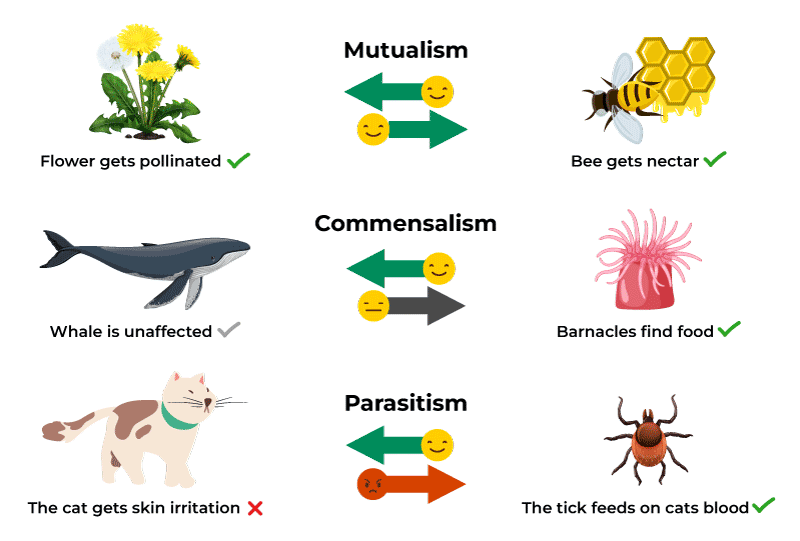What Is Symbiosis? Symbiotic Relationship And Its Types
Last Updated :
30 Oct, 2023
Symbiosis is referred to as a term that is a close, frequently ongoing relationship between two different species in an ecosystem. In simple words, it is a connection between two organisms. There are three different kinds of symbiotic relationships: commensalism, parasitism, and mutualism. Symbiotic relationships play a critical role in the development of ecological communities, the promotion of biodiversity, and the overall health and harmony in ecosystems. Let's take a look at its types in this article.
What is Symbiosis?
Symbiosis is any form of partnership or interaction among two biologically distinct beings in which each may gain benefits from the other that they would not have normally. These connections, which can range from mutually beneficial to rivalry and even parasitism can be both exciting and challenging.
Types of Symbiosis
Following are the different types of symbiosis are:
Mutualism
In a mutualistic symbiosis, both of the involved species benefit from the relationship. For example, the interactions between plants and pollinating organisms such as those between bees and flowers, in which the plant offers nectar as a food source and the pollinator helps in the reproduction of the plant by spreading pollen. Two types of Mutualism are:
- Obligate Mutualism: The survival of both species is dependent upon one another. For instance, most plants and mycorrhizal fungus work together to assist plants absorb nutrients and to supply the latter with carbohydrates.
- Facultative Mutualism: Both species gain from their interaction, but they may live on their own without harm. For example, the association of oxpeckers with huge beasts in Africa, the birds consume parasites on the beasts skin.

Parasitism
In a parasitic relationship, one species gains at the expense of the other. For instance, Fleas that feed on mammals, tapeworms that live in animals intestines and numerous pathogens. Types of Parasitism are:
- Endoparasitism: Parasites that live inside their host. For example- tapeworms in the intestines.
- Ectoparasitism: These are the parasites which live on the surface of their host. For example- ticks, fleas and lice.
- Brood Parasitism: Some birds, like cuckoos, lay their eggs in the nests of other bird species, leaving the host birds to care for their young.
- Parasitoidism: Certain wasps lay their eggs inside the bodies of other insects. When the wasp larvae hatch, they consume the host from the inside.
Commensalism
It is an interaction in which one species gains while the other is not severely damaged or benefitted. As an example, consider how barnacles may stick to the skin of a whale or the shell of a sea turtle and have access to the nutrients in the ocean without severely harming the host. Types of Commensalism are:
- Phoresy: When one organism transports another without endangering the host. For instance, mites can use insects as a means of transportation by attaching to them.
- Microbiota: Different kinds of bacteria live in human digestive system that benefit the environment while having a small or no effect on the person.
- Epiphytism: Orchids and other epiphytic plants grow on the root systems of trees. They don't hurt the tree and just use it as a support.
Advantages of Symbiosis
Following are the advantages of symbiosis:
- Resource conservation: In commensalism and mutualism, species can save energy and resources by cooperating on tasks or receiving the benefits of their partners' efforts, as in the instance of gut bacteria aiding in digestion.
- Nutrient Exchange: Exchange of critical nutrients and resources between symbiotic partners is common and can help to promote each other's growth, development, and general fitness.
- Benefits for Reproduction: Many symbiotic relationships, particularly mutualism, promote reproduction by behaviors like pollination, seed dissemination or even offspring protection.
- Increased Biodiversity: By fostering the coexistence of many species in ecosystems and generating roles for them to occupy, symbiotic connections contribute to the general diversity of life.
Disadvantages of Symbiosis
Following are the disadvantages of symbiosis:
- Reduced Fitness or Health: In parasitic alliances, the host organism often suffers a decline in fitness as the parasite depletes resources or poses a threat to its health. The host may experience a decline in growth, reproduction and general health as a result.
- Trade-offs: Symbiotic links frequently entail trade-offs, in which advantages in one element of an organism's life are sacrificed for those in another.
- Energetic Costs: Maintenance of the union or provision of resources for the partner can result in energetic costs.
- Reduced Independence: As a result of becoming dependent on their hosts for transportation or other advantages, commensal organisms may be less able to exist independently in a variety of habitats.
FAQs on Symbiosis
1. What Distinguishes Mutualistic Symbiosis from Parasitic Symbiosis?
Unlike mutualistic symbiosis, which helps both species, parasitic symbiosis enriches one species at the expense of the other.
2. How are Ecosystems impacted by Symbiotic Relationships?
Symbiotic connections affect ecosystems overall health and balance, species diversity and nutrient cycling.
3. What are the Bnefits and Drawbacks of Symbiosis for living things?
The benefits include improved protection, increased access to resources and reproductive success. However, drawbacks can exist, such as diminished fitness, rivalry and dependence on the other person.
4. Do Symbiotic Relationships affect Evolution over the long term?
It is true that symbiotic relationships can result in coevolution, in which species change in response to one another. Over time, these interactions may promote the emergence of specialized features and adaptations.
5. How do Researchers examine Symbiotic Interactions in the Real World?
To research symbiotic relationships to understand their dynamics in various ecosystems, scientists employ a range of techniques, such as field observations, experiments in the lab, genetic analysis and ecological modelling.